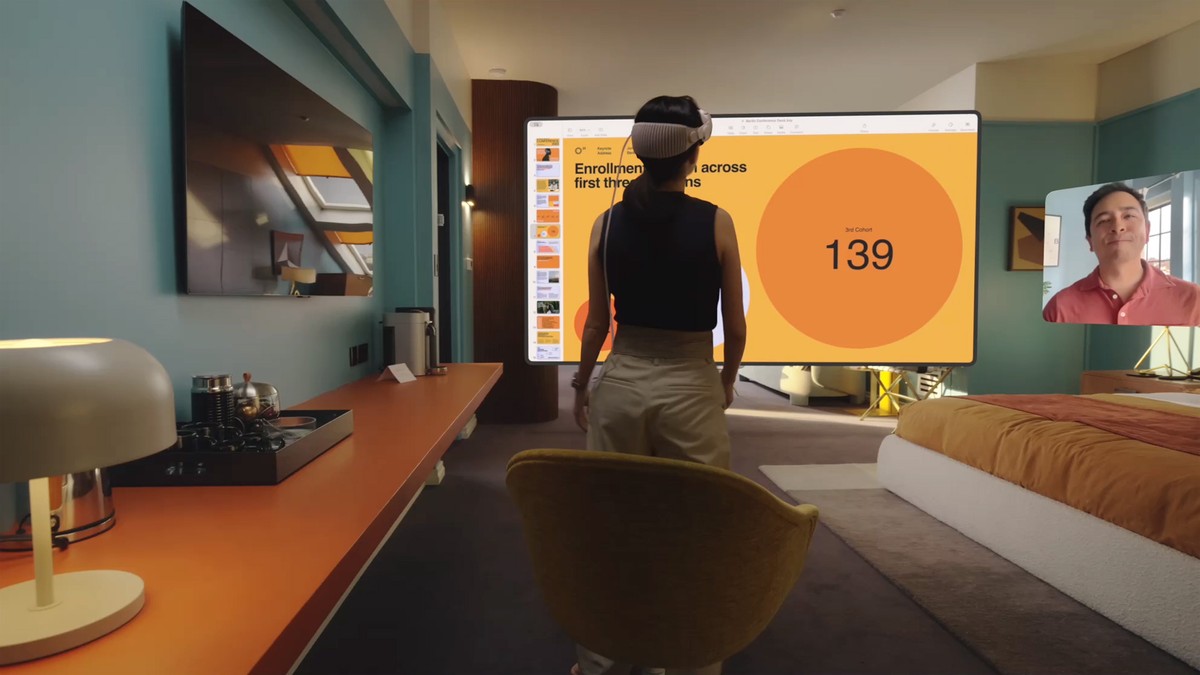Apple has introduced the highly anticipated Apple R1 chip—a processor specifically designed to power their revolutionary mixed-reality headset, the Apple Vision Pro. With its unique capabilities and seamless integration with the M2 chip, the R1 processor is set to redefine the immersive experience.
The Apple R1 processor takes center stage as a dedicated chip meticulously engineered to meet the demands of mixed-reality headsets, with the Vision Pro being a prime example. Functioning in harmony with the M2 chip, which powers Apple's renowned MacBook Air, the R1 processor brings a new level of sensory immersion and interactivity to users.

Apple R1 chip is designed to power Apple Vision Pro - Image courtesy of Apple
What Apple R1 chip is capable of?
The Apple R1 chip complements the M2 processor by assuming responsibility for processing data gathered from a remarkable suite of sensors incorporated into the Vision Pro headset.
With an impressive ensemble of 12 cameras, 5 sensors, and 6 microphones, the R1 chip processes incoming information with exceptional speed. Impressively, it achieves this feat in an astonishing 12 milliseconds—8 times faster than the human blink. This rapid processing is crucial to minimizing delays and ensuring a seamless experience, ultimately reducing the risk of motion sickness and disorientation among users.
Mitigating motion sickness and disorientation
One of Apple's primary objectives with the Apple R1 chip is to address the challenges of motion sickness commonly associated with virtual and augmented reality experiences. By delivering real-time processing of sensory input, the Apple R1 chip enables users to perceive their surroundings with minimal latency. Any perceptible lag between physical movement and corresponding visual feedback can trigger motion sickness, compromising the user's comfort and experience.
The Apple R1 chip's lightning-fast processing significantly reduces the likelihood of such issues, allowing for smoother and more enjoyable mixed-reality interactions.

Users will have minimal latency while interacting with their surrounding in mixed-reality space thanks to the Apple R1 chip - Image: Apple
Battery life considerations
While the inclusion of both the R1 and M2 chips in the Vision Pro headset provides unparalleled performance, it does come at a cost. With two processors simultaneously at work, the battery life of the headset is limited to approximately two hours on a single charge. This may come as a surprise to MacBook Air users, who have come to appreciate the M2 chip's impressive energy efficiency. However, given the demanding processing requirements of the R1 chip, additional power consumption is unavoidable. It is important for users to consider this limitation when planning extended use of the headset and to make provisions for recharging as needed.
The high price of high technology
The advanced technology and innovative design that goes into developing the Apple R1 chip inevitably contribute to the overall cost of the Vision Pro headset. Priced at $3499, the headset is a significant investment. While the inclusion of both the R1 and M2 processors certainly plays a role in this higher price point, it is essential to acknowledge the comprehensive range of cutting-edge features and capabilities offered by the Vision Pro.
As with any premium product, the cost reflects the level of technology, sophistication, and immersive experience that Apple aims to deliver to its discerning users.

The Apple R1 chip is unfortunately the reason behind the skyrocketing price of Apple's AR headset - Image: Apple
The Apple R1 chip, together with the M2 processor, propels the Apple Vision Pro headset into a league of its own. By integrating the R1 chip's lightning-fast processing capabilities, Apple has mitigated the challenges of motion sickness, ensuring a smoother and more immersive mixed-reality experience.
Despite the impact on battery life and the higher price point, the Vision Pro's innovative technology and unmatched performance justify its status as a game-changer in the sector of mixed reality.



3175x175(CURRENT).thumb.jpg.b05acc060982b36f5891ba728e6d953c.jpg)
Recommended Comments
There are no comments to display.
Join the conversation
You can post now and register later. If you have an account, sign in now to post with your account.
Note: Your post will require moderator approval before it will be visible.